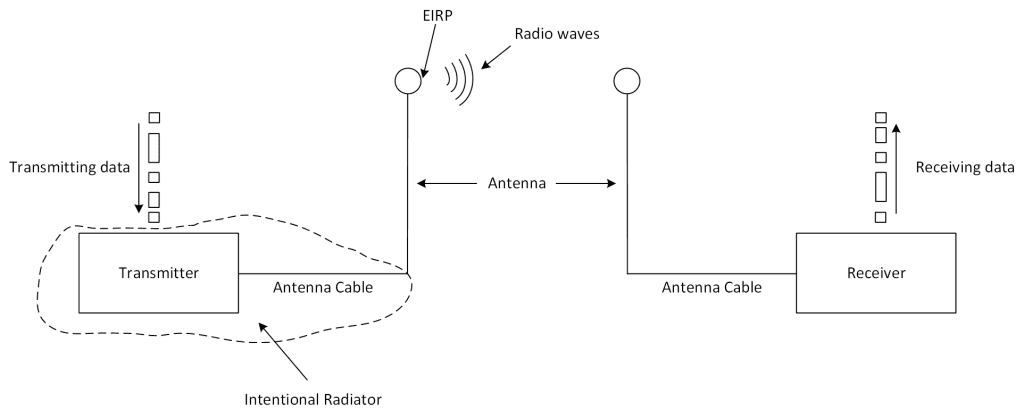Many factors contribute to the successful transmission and reception of a wireless signal. This post will focus on the most common Wi-Fi communications components and each device’s role in transferring data in wireless systems.
- Wi-Fi Component Overview
- Transmitter
- Antenna
- Receiver
- Intentional Radiator
- Equivalent Isotropically Radiated Power (EIRP)
Wi-Fi Component Overview
The image below illustrates the key components discussed in the subsequent sections.

Transmitter
The transmitter takes raw data from the computing device and converts it into an alternating current (AC) signal, determining the radio transmission frequency. For example, the 5GHz channel 48 has a centre frequency of 5.24GHz. The transmitter oscillates a signal at 5.24 billion times per second to send a signal on channel 48. It then modulates the AC signal to encode data into the signal, sending it directly to the transmitting device’s antenna or the antenna cable.
The transmitter is also responsible for determining the signal’s transmit power (amplitude). The higher the amplitude, the greater the distance the signal can travel. The administrator can typically configure the required transmit power on wireless infrastructure (access point or wireless router). Under normal circumstances, manufacturers recommend that client devices (laptops, tablets, and mobiles) transmit power settings are left at their default values.
Antenna
When attached to a transmitter, an antenna converts an electrical signal into electromagnetic waves before radiating it toward the receiver. Conversely, when connected to a receiver, the antenna captures the electromagnetic waves and converts them back into electrical signals that the receiver can process.
It’s important to note that a receiver will always receive a signal at levels much lower than the transmitter sent it, even in open space. Free space path loss (FSPL), a natural result of the inverse square law, causes this.
Receiver
The receiver takes the carrier signal from the antenna and decodes it into digital data (1s and 0s). The data is then sent to the computing device for processing. The receiver also plays a crucial role in ensuring the integrity of the received data by checking for errors and implementing error correction techniques.
Intentional Radiator
In simple terms, the intentional radiator (IR) is a device that intentionally generates and emits RF energy instead of a device that unintentionally generates RF energy as a byproduct of its primary function, such as a motor that generates RF noise. The IR comprises all components of the wireless transmission system up to, but not including the antenna.
Regulatory bodies impose limits on the IR’s power output. They measure the power level where the IR connects to the antenna, where the signal transmits. They typically quantify the power level in milliwatts (mW) or decibels relative to 1 milliwatt (dBm).
Equivalent Isotropically Radiated Power (EIRP)
EIRP measures the total power that a wireless transmitter sounds out in all directions. You calculate it by combining the transmitter’s output power and the antenna’s gain. Often, people use EIRP to assess the potential impact of a wireless transmission on other users of the same frequency band and to ensure the transmission complies with regulatory limits on maximum permissible power levels. For the Aussies, check out my Australian EIRP limits poster for the 2.4 and 5 GHz bands.
wow….super cool thanks…..